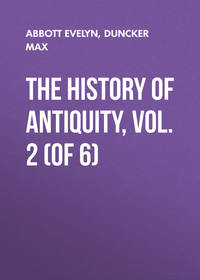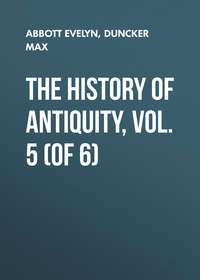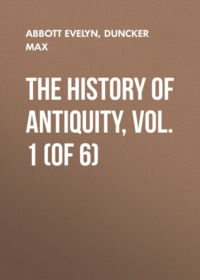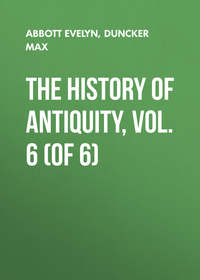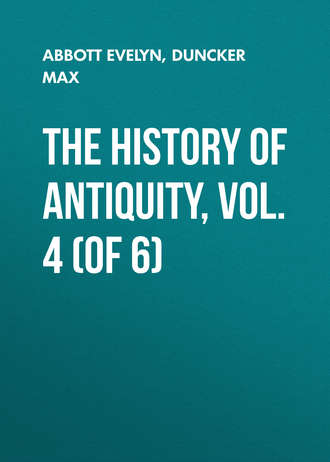 полная версия
полная версияThe History of Antiquity, Vol. 4 (of 6)
168
Manu, 1, 88-91, and in many other places.
169
In Manu, 4, 88-90 (cf. 12, 75, 76) eight hells are mentioned and described, in each of which the torments grow worse as the offences are more serious. The Buddhists retain these eight hot hells, and add eight cold; Burnouf, "Introduction à l'histoire du Bouddhisme," p. 320, 366, 367, 201. The Singhalese have increased the number to 136, the Siamese to 462. Koppen, "Relig. des Buddha," s. 244. Cf. A. Weber, in "Z. D. M. G." 9, 237.
170
e. g. Manu, 9, 335.
171
Manu, 12, 43, 44.
172
Manu, 12, 59.
173
Manu, 12, 55.
174
Manu, 12, 62, 64.
175
Manu, 12, 67.
176
Manu, 12, 58.
177
Manu, 12, 59. Burnouf, "Introduction," p. 274. Bohlen has already observed that many of these regenerations are merely fanciful, "Indien," 24.
178
Manu, 6, 61-63.
179
In the sixth century B.C. the Brahmanic arrangement of the state was in full force in the cities on the Ganges, and carried out most strictly. Hence it must have obtained the upper hand about 800 B.C. at the latest. It was not only established by law about the year 600 B.C., but the doctrine of the Brahmans had already created scholastic and heterodox systems of philosophy. Before this system could become current, the idea of Brahman must have been discovered; the strong elements of resistance in the ancient life and faith must have been overcome. This would occupy a space of about two centuries, and may therefore have filled the period from 1000 to 800 B.C., as assumed in the text. Buddhism required a space of three centuries in order to become the recognised religion in the kingdom of Magadha. Before the idea of the world-soul could be discovered, the hymns of the Veda must have reached a certain point of combination and synopsis, and the confusing multitude of divine forms must have been sufficiently felt to call forth the opposite idea of unity. From the book of the law it is clear that the three Vedas were in existence before it was drawn up. It refers perpetually to the triple Veda. The evidence of the Sutras proves that four Vedas existed at the time of the appearance of Buddha. If these were in existence in the sixth century the three which are acknowledged to be older must have existed as early as the seventh century B.C.
180
Manu, 2, 6, 12, 18, 20.
181
Manu, 9, 67.
182
Manu, 7, 38-42, 8, 110.
183
Muir, "Sanskrit Texts," 1, 268, 305.
184
Muir, loc. cit. 1, 297 ff.
185
Muir, loc. cit. 1, 307 ff.
186
Muir, loc. cit. 1, 157.
187
Muir, loc. cit. 1, 151, 200.
188
The participation of all the Gotras of the Brahmans, who claim to be derived from the Rishis, in the composition of the Rigveda, has been acutely and convincingly proved by M. Müller. "Hist. of Sansk. Lit." p. 461 ff.
189
A. Weber, "Z. D. M. G." 10, 389 ff.
190
Strabo, p. 717. Lassen, "Ind. Alterth." 1, 840; 2, 215-223. M. Müller considers that the use of writing was known to the Indians before 600 B.C., but nevertheless is of opinion that the Veda was written down later, and allows no written work to the Indians before 350 B.C., the date at which he fixes Panini: "Hist. of Sansk. Lit." p. 311, p. 477 ff. Since, however, the Brahmanas date from between 800 and 600 B.C., which is M. Müller's opinion, it is hardly credible that controversies, and discussions, and examples, such as we find largely in the Brahmanas, could have received a fixed form if they merely referred to groups of poems retained in the memory only, though of considerable extent. That the Brahmanas existed in memory only seems to me to be quite impossible, considering their form. How could Çaunaka, about the year 400 B.C. as M. Müller supposes, write sutras to facilitate the understanding of the Brahmanas, if the latter were not in existence in writing? A. Weber has observed that in Panini the 60 pathas of the first nine books of the Çatapatha-Brahmana are quoted, and the 30 and 40 Adhyayas of the Aitareya and Kaushitaki-Brahmanas. In my opinion, the fact so acutely and convincingly proved by M. Müller – that the Rigveda is allotted to all the Gotras of the Brahmans, is strongly in favour of the composition of the Vedas in a written form; the tradition of the Gotras and the schools would never have given equal attention to all. If the Brahmanas, which cite the Vedas accurately in their present arrangement, and speak not only of syllables but of letters, arose between 800 and 600 B.C., it appears to me an inevitable conclusion that the Vedas must have existed in writing about the year 800 B.C.
191
Kaegi, "Rigveda," s. 3.
192
Madhusudana, in M. Müller, "Hist. of Sansk. Lit." p. 122; cf. p. 173, 467.
193
Roth, "Zur Literatur des Veda," s. 11. A. Weber, "Vorlesungen," s. 83, 84. Westergaard, "Aeltester Zeitraum der Ind. Gesch." s. 11. For the legends of the Puranas on the origin of the black and white Yajus, which allow the superior antiquity of the first, see M. Müller, loc. cit. p. 174, 349 ff.
194
Lassen, "Ind. Alterth." 1, 776.
195
A. Weber, "Vajasaneya-Sanhitæ specimen," p. 33.
196
"Rigveda," 1, 33, "Ye Açvins, come with the three and thirty gods."
197
Burnouf, "Commentaire sur le Yaçna," p. 34 ff., and below.
198
"Rigveda," 3, 9, 9; A. Weber, "Ind. Studien," 9, 265. Yajnavalkya gives 33,000 gods; later we find 330 millions.
199
Manu, 3, 69-74, 141-148, 158, 187-238, 266-274, 282, 283. 4, 25, 26. 11, 7. Of. Roth in "Z. D. M. G." 8, 471 ff.
200
Manu, 5, 26-28; 54-56.
201
Manu, 3, 94-118.
202
Manu, 2, 101-103.
203
Manu, 11, 216.
204
Manu, 11, 212.
205
Manu, 11, 211.
206
Manu, 11, 108-116. Even to this day it is a custom in Bengal for a man whose cow has died to wander from house to house with a rope round his neck, to imitate the lowing of a cow, and without uttering a word go on begging until he has collected enough to buy a substitute.
207
Oder sich selbst entmannen, und seine Scham in der Hand südostwärts (d. h. dem Reiche Jama's zu) wandern, bis er todt hinstürzt. [Cf. Manu, 11, 104, 105.]
208
"Rigveda," 3, 62.
209
Manu, 3, 84 ff.
210
Manu, 2, 76-78; A. Weber, "Ind. Studien," 2, 188, 305.
211
Der, welcher im Angesicht des Feuers, der Sonne, des Mondes, einer Cisterne, einer Kuh, eines Dvidscha, oder gegen den Wind urinirt, wird seiner ganzen Schriftgelehrsamkeit beraubt werden. Der Brahmane darf seinen Urin nicht lassen, und seine Excremente nicht niederlegen, weder auf den Weg noch auf Asche, noch auf eine Kuhweide, noch auf einen Ameisenhügel, noch auf den Gipfel eines Berges, noch in ein Loch, welches lebende Wesen bewohnen können, weder gehend noch stehend. Nachdem er die Erde mit Holz und Blättern und trockenen Kraütern bedeckt hat, kann er seine Bedürfnisse schweigend, in sein Gewand gehüllt und verhüllten Hauptes, verrichten. Bei Tage muss er dabei sein Gesicht nach Norden wenden, bei Nacht gegen Süden. Lassen sich die Himmelsgegenden in der Dunkelheit gar nicht unterscheiden, oder hat der Brahmane einen Ueberfall durch Räuber oder wilde Thiere zu befürchten, so kann er sein Angesicht dahin richten, wohin es ihm beliebt. Niemals aber darf er Excremente ansehen, weder seine eigenen noch fremde. [Manu, 4, 45 ff.]
212
The daily duties which the Brahmans have now to perform, are given in Belnos, "Daily Prayers of the Brahmins."
213
Manu, 1. 87-91; 2, 31, 32.
214
Muir, "Sanskrit Texts," 3, 149, 150.
215
Manu, 2, 69-76; 164-168; 173-181. On the reading of the Veda in the schools cf. Roth, "Zur Literatur und Geschichte des Veda," s. 36.
216
Manu, 2, 66, 67; 3, 1.
217
Manu, 6, 1-8, 22, 23, 76, 77.
218
Manu, 6, 69, 79-85, 96.
219
Manu, 6, 38.
220
Talboys Wheeler, "Hist. of India," 2, 247.
221
Müller, "Hist. of anc. Sansk. Lit." 133 ff; 200 ff. Lassen, "Ind. Alterth." 2, 80; Johaentgen, "Gesetzbuch des Manu," s. 108, 163.
222
Manu, 2, 17, 18, 21-23, 24.
223
Manu, 3, 16; 8, 140. If Vasishtha and Çaunaka, as lawgivers, did not mean the old Rishis and, apparently, some traditional statements of theirs, but the first name referred to the Vasishtha-dharma-çastra, and thus to the teacher of Açvalayana, these quotations like many passages would be interpolations; and those of Çaunaka would not be very late, for M. Müller places this Çaunaka about 400 B.C. "Hist. of Sansk. Lit." p. 242 ff.
224
Manu, 8, 41, 46.
225
Manu, 1, 119; 12, 126.
226
There was a school of Brahmans, the Manavas, belonging to the Madhyandinas, whose text-book was the black Yajus. From the name Manava, Johaentgen concludes that it is the redaction of the Manava-school in which we have these laws, and that Manu's book is really the book of the Manavas. According to the tradition of the Indians, there ought to be three redactions of Manu, of which one numbers 4000 verses. The copies known as yet, and accessible to us, have only 2285 verses.
227
Jolly, "Z. Vgl. Richtsw., Die Systematik des indischen Rechts."
228
Cf. Stenzler, "Indische Studien," 1, 236, 246. Lassen, loc. cit. 12, 999.
229
Buddha's active life falls, as we shall see, in the period from 585 to 543 B.C. According to the sutras of the Buddhists, the Brahmanic law was then in full force; in fact in the districts mentioned in the text stricter rules were in force than those of the laws of Manu. The law is cited in the legends of the Buddhists, e. g. Burnouf, "Introduct. à l'histoire du Boud." p. 133; cf. Manu, 2, 233. It is true we possess the old sutras of the Buddhists in the form which they received in the third century B.C.; but Buddha's appearance presupposes the prevalence of the Brahmanic system, the supremacy of the doctrine and practice of it. In opposition to Buddhism the system of castes has not been softened by the Brahmans, but demonstrably strengthened. Moreover, the description of the legal and social conditions given in the sutras cannot be suspected to be mere inventions. The book of the law knows three Vedas only (cf. Manu, 4, 124); the sutras always quote four. In Manu the sentence of the Atharvan is mentioned once only (11, 33); hence the Atharva-veda seems to be later than Manu's law. In the Buddhist sutras the worship of Çiva is mentioned very frequently as in common use (Burnouf, loc. cit. p. 131); but the book of the law knows neither the name nor the god. From the accounts of the Greeks it is further clear that the worship of Vishnu was widely spread towards the end of the fourth century. This name the book contains only once, in the concluding part (12, 107-126), which has very little connection with the body of the book; and even here the word is used in the same sense as in the Rigveda (12, 121). While Ceylon was occupied by the Aryas about the year 500 B.C. and the southern Mathura was founded even earlier, the knowledge of places in Manu's law does not really go beyond the Vindhyas towards the south: the Odras and Dravidas are merely mentioned in a general enumeration of nations (10, 44), and the Andhras as an impure caste (10, 36, 49). The kingdoms of Mathura and Kerala would certainly have been mentioned if they had been in existence. The book of the law mentions the Nyaya (logic), the system of Mimansa, though only in the suspected conclusion (12, 109, 111), but not the Buddhists. It is true expressions occur, like liars (Nastika, 2, 11), revilers of the Veda (Vedanindaka), but we know that before Buddha the Sankhya doctrine denied both the gods and the Veda. I can, therefore, concede to Johaentgen (who places the book between 500 and 350 B.C.) that germs and analogies from the Sankhya doctrine occur in it, especially in the doctrine given in the introduction of the elements and properties (1, 74-78); this requires no alteration in the date. It ought to be observed that in the book of the law the kings and heroes of the Epos are not mentioned at all, but names of kings are found which occur in the Vedas: Vena, Nahusha, Pijavana, Sumukha, Nimi, Prithu (Manu, 7, 41, 42; 9, 44, 66); hence we may conclude that the book was brought to a close before the revision of the Epos from a priestly point of view was accomplished, or at any rate became a common possession of all. M. Müller's position, that the anushtubh çlòka was first used in the last centuries B.C., would affect only the form of the book, not the rules themselves; and Goldstücker is of opinion that this metre is of a far older date. However this may be, the metrical redaction of the Manava-dharma-çastra is not its original form: it is based upon a non-metrical Dharma-sutram. That the oldest Grihya-sutras and Çrauta-sutras are older than the first Dharma-sutra is allowed; but this does not prove the modern origin of the latter. A complete civilisation like that exhibited to us in the philosophy and grammar of the Indians before Buddha, by the sutras of the Buddhists and the accounts of the Greek, was certainly not without a systematic canon to answer the questions in life for the Brahmans. They required the power of the state, and could not leave it without a guide. It would be inconceivable how the condition of India, which Buddha finds, could have grown up without such a guide for princes and judges. Müller himself maintains that the distinction of Çruti and Smriti existed before Buddha; that it was the Çruti already containing Mantras and Brahmanas, which gave the impulse to his reforms. "Hist. of Sansk. Lit." p. 78 ff,; p. 86, 107, 135. If Çaunaka wrote, as Müller concludes, about the year 400 b. c., his sutras for the elucidation of the understanding of the Brahmanas, and Açvalayana wrote the sutras of ritual about the year 350, and Panini his grammar, far more important Dharma-sutras must have been written for the Brahmans before this time, and thus the grounds given above and taken for the contents of the book are in my judgment supported. From these contents, and these essential precepts, two or three prohibitions might be made to count for a later origin (Manu, 4, 102, 114; 8, 363), precepts aimed at Buddhism, but which may also have had other heterodoxy in view. There is also the mention of the name of Yavana. The Yavanas are mentioned among the nations who have sunk owing to omission of the sacred customs, along with the Odras, Dravidas, Kambojas, Duradas, Çakas and Pahlavas (10, 44). Supposing that this list came from an older time, the Yavanas Çakas and Pahlavas may easily have been interpolated at a later period for the sake of completeness. In any case it is clear that the laws of Manu are the oldest book of law in India in their contents and theory of law, and that the material in it is in part older than the material in the Dharma-sutras which have come down to us; Jolly, loc. cit. It is only in regard to the law of debt that Jolly seems to find older regulations in the book of Gautama than in that of Manu. "Abh. M. A." 1877, s. 322.
230
Manu, 1, 35.
231
Manu, 1, 1-78, 119; 12, 126. The four periods of the world are mentioned in Kaushitaki-Brahmana, in M. Müller, "Hist. of Sansk. Lit." p. 412.
232
Manu, 7, 4-11.
233
Manu, 5, 96.
234
Manu, 9, 304-309.
235
Manu, 7, 8.
236
Manu, 9, 301, 302.
237
e. g. Manu, 7, 2.
238
Manu, 7, 82-86.
239
Manu, 7, 26, 27, 31; 8, 175; 9, 251.
240
Manu, 8, 1-3, 23-26; 61-70.
241
Manu, 8, 88.
242
Manu, 8, 75, 82, 89-99.
243
Manu, 8, 113.
244
Manu, 8, 110, 114-116. A. Weber, "Ind. Stud." 9, 44, 45.
245
In Yajnavalka, 2, 95, we find: "The balance, fire, water, poison, and lustral water are the judgment of the gods for purification; these are applied in great charges, if the accuser is prepared for a fine." The later law knows nine divine judgments; it adds the corns of rice, the hot piece of gold, the ploughshare, and the lot. Brahmans, women, children, old men, sick persons, and the weak are to be tested by the balance; the Kshatriya by the fire, the Vaiçya by water, the Çudra by poison. In the test of the balance (Yama weighed the souls on scales, supr. p. 137), the point was that the person to be tested should be found lighter on the second weighing than on the first; in the test of fire, a piece of red-hot iron, covered with leaves, must be carried seven paces forward; each burn was a mark of guilt. The red-hot ploughshare must be licked by the accused person; if his tongue was not burnt he was acquitted; a piece of gold must be picked out of boiling oil and the hand must show no marks. The taking of a particular poison which ought to have no evil effects on the accused, and the drinking of lustral water poured over the images of the gods, which was not to be followed by any evil effects, and the piece of gold in the boiling oil are later additions. According to an Upanishad to the Samaveda, guilt or innocence is proved by the grasping a red-hot axe; a burn is a proof of guilt. Stenzler, in "Z. D. M. G." 9, 662 ff. A. Weber, "Vorles." s. 792.
246
Manu, 8, 11, 21.
247
Manu, 9, 276. Burnouf, "Introduction," p. 413.
248
Burnouf, loc. cit. p. 408. Yet Aryas are found also, Burnouf, loc. cit. p. 365.
249
Manu, 9, 237, 239-242.
250
Manu, 9, 275.
251
Manu, 9, 232.
252
Manu, 9, 279.
253
Manu, 8, 344-347.
254
Manu, 9, 261-268, 278.
255
Manu, 9, 276.
256
Manu, 9, 277.
257
Manu, 8, 341, 342.
258
Manu, 7, 130.
259
Manu, 8, 398; 7, 131.
260
Manu, 7, 118, 138.
261
Manu, 7, 62.
262
Manu, 7, 129.
263
Manu, 7, 133.
264
Bohlen, "Indien," 2, 46.
265
Megasthenes, in Strabo, p. 708 and below.
266
Manu, 7, 54.
267
Manu, 7, 58, 59.
268
Ramayana, ed. Schlegel, 1, 7.
269
Manu, 7, 114.
270
Manu, 7, 116-118.
271
Manu, 7, 123.
272
Manu, 7, 118-120.
273
Manu, 7, 124.
274
Manu, 6, 69-75.
275
Manu, 7, 126. The Indians learned to coin money from the Greeks after the year 300 B.C.; till that time their coinage consisted of weighed pieces of copper, silver, and gold, with the mark of the weight as a stamp. The pana is a copper weight of this kind; to this day the name denotes copper money in India. The drona is a weight of about 30 pounds. Cf. Lassen, 2, 574.
276
Manu, 7, 37.
277
Manu, 7, 218.
278
Manu, 7, 222.
279
Manu, 7, 224-226.
280
Manu, 7, 101-103.
281
Manu, 7, 154-158.
282
Manu, 7, 63-68.
283
Manu, 7, 107, 158-163, 198.
284
Manu, 7, 205, 210.
285
Manu, 7, 90-93.
286
Ramayana, 2, 52.
287
Ramayana, 2, 1-17.
288
Burnouf, "Introduction," p. 166, 416, 417. The ritual for the consecration of kings, according to the Aitareya-Brahmana, is given in Colebrooke, "Asiatic Researches," 8, 408 ff. Cf. Schlegel, "Ind. Bibliothek," 1, 431, and Lassen, "Alterth." 2, 246, 427.
289
Grimm, "Rechtsalterthümer," s. 156 ff.
290
Manu, 3, 150 ff.
291
Manu, 8, 229-260.
292
Mill, "History of British India," 2, 66. Montgom. Martin, "Political Constitution of the Anglo-Eastern Empire," p. 271.
293
Burnouf, "Introduction," p. 242, 245, 247.
294
e. g. "Ramayana," 1, 13, 72, ed. Schlegel.
295
Manu, 8, 380, 381.
296
Manu, 2, 127.
297
Lassen, "Ind. Alterth." 2, 80.
298
Manu, 9, 322.
299
Manu, 10, 80-117.
300
Burnouf, "Introduction," p. 139.
301
Manu, 3, 12-15, 44; 9, 22-24, 85-87.
302
Manu, 3, 16-19; 10, 5, 6.
303
Manu, 10, 15.
304
Manu, 10, 46.
305
Manu, 10, 48.
306
Manu, 10, 8.
307
Lassen, "Ind. Alterth." 1, 820, n. 2.
308
Manu, 10, 49.
309
Manu, 10, 48.
310
Manu, 10, 15; (above, p. 15).
311
Manu, 10, 51-56; (above, p. 168).
312
Manu, 10, 67.


